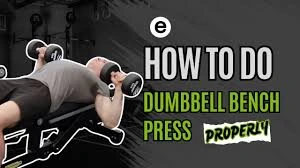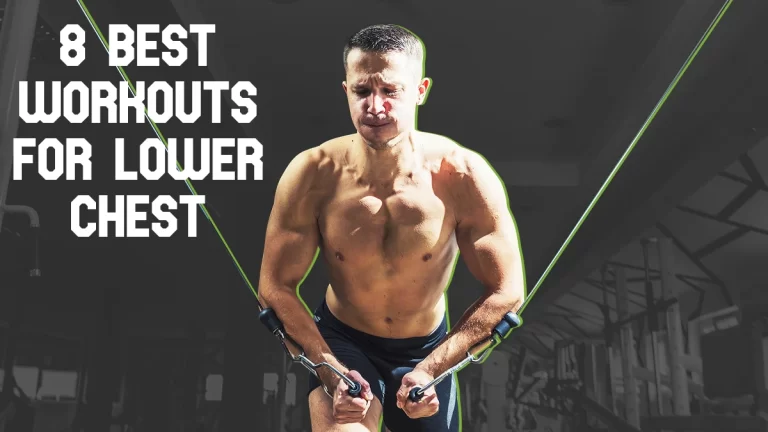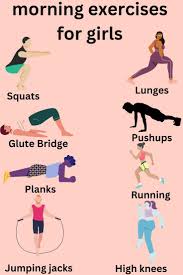Dumbbell Bench Press
The Dumbbell Bench Press is a strength training exercise that targets the chest, shoulders, and triceps. It involves pressing two dumbbells upward while lying on a flat bench, promoting muscle balance and stability.
It offers a greater range of motion and helps improve muscular balance by engaging stabilizing muscles more effectively. To prevent shoulder and pec issues, it is frequently advised to perform an alternate form of the barbell bench press; the dumbbell bench press is an exercise that helps strengthen the chest muscles.
It is commonly recommended to execute the dumbbell bench press after reaching a specific level of strength with the barbell bench press in order to avoid shoulder and pec problems. The dumbbell bench press acts as an ego check for the amount of weight used because it necessitates shoulder stability throughout the exercise. You can use the exercise as an auxiliary lift to the bench press or as a key lift in your sessions, depending on your goals.
Table of Contents
What is the Dumbbell Bench Press?
Your arm, shoulder, and chest muscles are worked out as you perform the dumbbell bench press, sometimes referred to as the dumbbell flat bench press or dumbbell chest press. To perform the dumbbell bench press, lie flat on a bench with a dumbbell in each hand, palms facing forward, and hold them at chest level with your elbows bent.
The dumbbells should be raised over your chest while using your glutes and core. As you drop your shoulder blades once again, squeeze them until your upper and lower arms are at a 90-degree angle.
Muscles Used While Performing Dumbbell Bench Press
- The pectorals, or chest, which includes the front side of the upper body, are the main muscles used in a dumbbell bench press.
- Bench pressing with dumbbells also strengthens the shoulders, especially the anterior deltoid, which assists the chest in extending the arms. Throughout the exercise, the whole deltoid muscle contracts isometrically to maintain the stability of the shoulder joint.
- When performing the bench press, the third main muscle group used is our triceps. A key aspect of the bench press is elbow extension, generated by the muscle that covers the rear of our upper arms. Our triceps work more when we extend our arms, yet when we are at the bottom, our chest works harder.
- In addition, our glutes, upper back (trapezius, lats, and rhomboids), and stomach (abs, transverse abdominis, and obliques) help with a dumbbell bench press. All of these muscles provide stability and isometric flexion during the workout.
How To Do Dumbbell Bench Press
- When performing dumbbell bench presses, start with a weight that you can lift for two to three sets of eight to twelve reps. You should pick a weight that will allow you to keep your posture throughout each set and repetition.
- Sitting on the bench, position a pair of dumbbells in the creases of your hips. The dumbbells should remain on your hips while you recline on the bench.
- Press the dumbbells toward the ceiling while using your core to get into position. Keep your hands in front of your torso and the dumbbells in line with your chest as you push them upward. Activate your lats by turning your shoulders outward.
- Until your upper arms and back are level, gradually leave the dumbbells while keeping your wrists neutral.
- Your upper and lower arms need to form a 90-degree angle, while your elbows must be positioned at 45 degrees from your chest.
- Keep applying pressure until your arms are long and your elbows are slightly bent.
- Keep the dumbbells apart as the workout draws to an end.
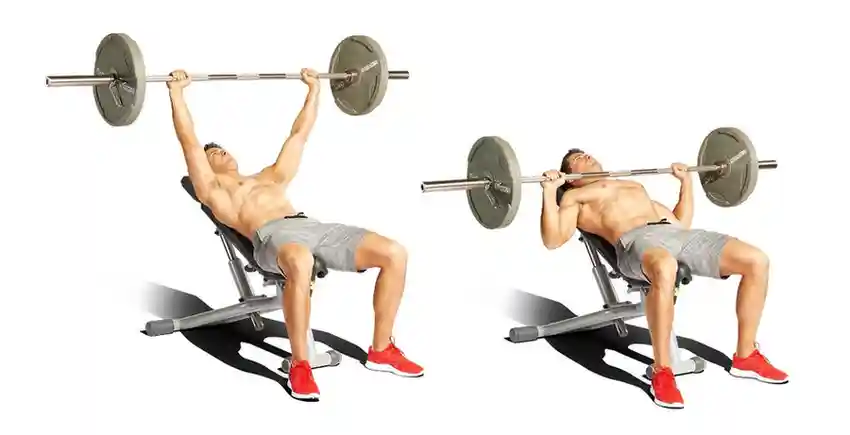
Variation In Performing Dumbbell Bench Press
- Incline dumbbell bench press
- Single-arm dumbbell bench press
- Decline dumbbell bench press
- Dumbbell floor press
- Neutral grip dumbbell bench press
- Dumbbell Squeeze Press
Incline dumbbell bench press: To execute the incline bench press, use a bench that can be adjusted to a 45-degree angle. This variation, which involves a slight elevation change, targets your upper chest muscles more than a typical dumbbell bench press.
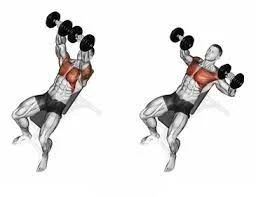
Single-arm bench press: Stability becomes more challenging because you are only able to hold onto one weight. Pressing with just one arm is also a great technique for practicing concentration on one side at a time.
Decline dumbbell bench press: Compared to the regular adaptation, the decline bench press variation works your lower muscles and triceps more since it involves reclining back on an adjustable bench with your legs lifted over your shoulders.
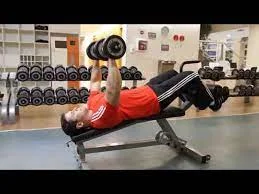
Dumbbell floor press: A useful variant that restricts your range of motion and maintains the most advantageous position for your shoulders is the dumbbell floor press. Another advantage of the floor press is that it keeps you from using the stretch reflex, which makes pressing the weight harder for your chest and triceps.
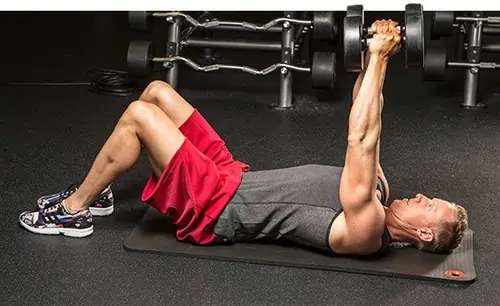
Neutral Grip Dumbbell Bench Press: Using a neutral grip—where your palms face each other—during dumbbell bench presses can help strengthen your triceps while reducing strain on the shoulder joints.
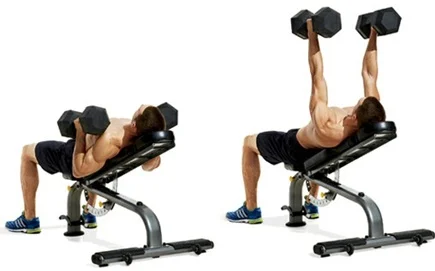
Dumbbell Squeeze Press: This variation involves pressing two dumbbells together while keeping your grip neutral. Chest activity is increased by extending your arms and squeezing your hands together.
Dumbbell Bench Press Video
Benefits Of Dumbbell Bench Press
Adding the dumbbell bench press to your weightlifting regimen can help you in several ways.
- Dumbbell-assisted bench presses help build upper-body muscles.
- A complete range of motion is possible with dumbbell bench presses.
- Dumbbell bench presses activate your stabilizer muscles
- Dumbbell bench presses promote muscle symmetry
Mistakes To Avoid While Performing Dumbbell Bench Press
- Your initial setup is one of the dumbbell press’s most frequent and harmful errors. A lot of trainees make the error of lifting the dumbbells off the floor while reclining on the bench. Doing so puts your shoulders at risk for injury, which makes it dangerous.
- Plus, if you start using bigger dumbbells, it’s almost impossible to set up that way anyhow.
- To begin, grasp the dumbbells firmly, sit on the edge of the bench, and rest the weights on your thighs. Then, lean back onto the bench in a controlled manner while simultaneously bringing the dumbbells to chest level, preparing for the press
- The use of excessive weight is the second important error to avoid. The heaviest dumbbells are chosen by many eager trainees who want to gain strength quickly. The problem is that lifting excessive amounts of weight affects technique, causes compensatory movement patterns, and limits range of motion.
- In addition to raising your chance of harm, each repeat loses effectiveness. The right weights should thus always be chosen such that you can do at least eight consistent repetitions using your whole range of motion.
Safety And Precautions
- Before starting an exercise program, speak with your doctor if you have a history of health issues. For a workout program to be safe and successful, proper technique is crucial, but depending on your demands, you might need to adjust each exercise to achieve the best results.
- Whenever choosing a weight, be sure it gives you complete control over your body during the exercise. During any workout, be mindful of your body and stop right away if you experience any pain or discomfort.
- Your training regimen should incorporate appropriate warm-ups, recovery, and nutrition if you want to see ongoing development and develop muscle. In the end, how well you recover from your workouts will determine your results.
- Before working out the same muscle groups, take a day or two off to allow for adequate healing.
Summary
Strength training exercises like the dumbbell bench press target the triceps, shoulders, chest, and stabilizing muscles like the glutes and core. It is a useful supplement or substitute for the barbell bench press, providing advantages such as enhanced range of motion, stability, and muscular activation.
Lowering the dumbbells to a 90-degree arm angle and then carefully raising them again is the proper method. Exercise variations that target distinct muscle regions include incline, decline, and single-arm presses. Starting with moderate weights, using proper setup procedures, and making sure you get enough time to recover are all crucial for preventing injury.
FAQ’s
The dumbbell press offers greater flexibility of motion compared to the barbell press, allowing for a more natural movement pattern and better muscle engagement. This expanded range of motion allows for deeper stretches and more powerful contractions of the targeted muscles.
Reduced capacity for maximal lifting. Dumbbells need greater stability than barbells, making it more difficult to set up and raise as much weight. This may restrict the maximum strength increases, but it also lessens the necessity for a spotter.
Dumbbells are likely superior to barbells for injury prevention and rehabilitation since they allow you to work out your upper body more fully and correct imbalances on the left and right.
For individuals who have never worked out before or haven’t worked out in a long time, 10 kg (22 lbs) of dumbbells will be enough to make a noticeable difference in your appearance at first, but you will eventually need to raise the weight to continue building muscle.
References:
- Stefanov, P. (2025c, May 30). Dumbbell Bench Press: how-to, tips, variations & more. Hevy – #1 Workout Tracker & Planner Gym Log App. https://www.hevyapp.com/exercises/bench-press-dumbbell/
- Lift Manual. (2023b, April 24). Dumbbell Bench Press – Guide, benefits, and form. https://liftmanual.com/dumbbell-bench-press/

